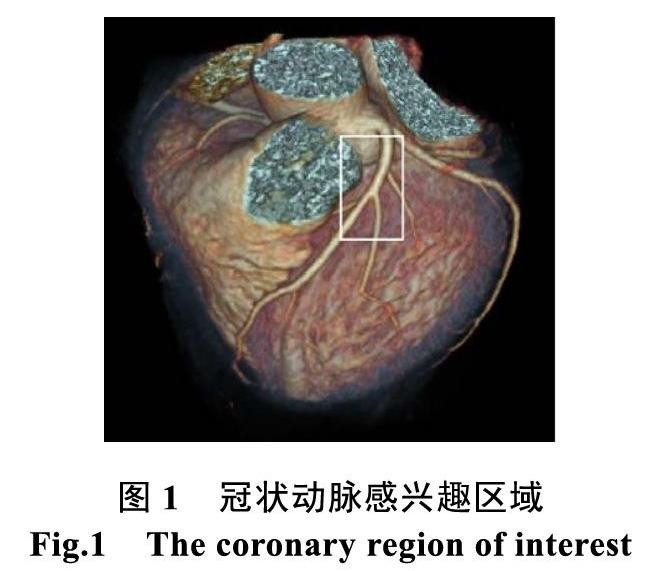冠状动脉的数值模拟分析及在支架介入的应用研究
2020-03-02隋国庆张培新杨国柱
隋国庆 张培新 杨国柱



摘 要: 本研究基于心脏活体冠脉 CTA 原始影像数据,采用医学影像交互式控制系统软件的最新冠状动脉分割算法,重构冠状动脉的个体化血管模型,应用计算流体力学技术对冠状动脉前降支及其分支进行血流动力学数值模拟分析。探讨了斑块对血流动力学参数的影响,进而研究了冠状动脉粥样硬化的形成、冠状动脉狭窄或梗死的发生和发展的特点与机制。该研究为临床的研究与治疗提供理论依据,同时可用于指导冠状动脉狭窄及梗死患者支架介入治疗的术前设计。
关键词: 冠状动脉;血流动力学;数值模拟;支架介入
中图分类号: TP319 文献标识码: A DOI:10.3969/j.issn.1003-6970.2020.01.023
本文著录格式:隋国庆,张培新,杨国柱,等. 冠状动脉的数值模拟分析及在支架介入的应用研究[J]. 软件,2020,41(01):110113
【Abstract】: Based on the original CTA image data of living coronary arteries, this study used the latest coronary artery segmentation algorithm of medical image interactive control system software to reconstruct the individualized coronary artery model, and applied computational fluid dynamics technology to conduct hemodynamic numerical simulation analysis of the anterior descending coronary artery and its branches. The effect of plaque on hemodynamic parameters was discussed, and the formation of coronary atherosclerosis, the occurrence and development of coronary artery stenosis or infarction were studied. This study provides a theoretical basis for clinical research and treatment, and can be used to guide the preoperative design of stent intervention in coronary artery stenosis and infarction.
【Key words】: Carotid artery; Numerical simulation; Haemodynamics; Stent intervention
0 引言
动脉粥样硬化(atherosclerosis,AS)是以大、中动脉内膜粥样硬化损伤为特征的血管病变,是心血管疾病发病的基本病因之一[1]。其形成主要与遗传基因、高血压、高脂血症、糖尿病、吸烟及精神压力等相关[2]。不同动脉 AS 的发生率有很大差异,AS 主要生成于大动脉及动脉分支处,其部位有明显的血流变化[3]。斑块形成在解剖学上有明显倾向性,与某种有选择定位作用的致病因素相关联。异常血液流动致动脉应力改变在AS形成过程中起着重要作用[4-5]。由于目前医学技术的局限性,无论是间接或者直接方式在人体冠状动脉测量血流动力学参数都存在很大的困难[4-5]。因此,基于医学影像技术,通过计算机技术建立人体冠状动脉的三维模型,对其进行血流动力学仿真分析,有重要的临床价值。借助目前广泛应用的三维重建技术,把患者身体上的特定部位,通过CT或核磁共振技术采集的各种数据经过软件的计算,呈现出被扫描部位的三维影像,可以更方便的观察我们感兴趣的区域[6]。
多数临床医学影像医生对冠状动脉的狭窄或梗死的诊断与介入治疗是以对CTA平扫图像的阅读为依据的[7]。然而平扫图很难提供准确的血管狭窄位置及物理特征与参数,更不能提供血流动力学参数及血管壁的力学参数,因此,很难准确的选择与之匹配的球囊支架的型号与弹性特征。本课题研究。本研究不仅可以探索冠状动脉狭窄或梗死形成和发展的血流动力学机制,而且可以提供冠状动脉狭窄或梗死血流动力学各项参数的检测和分析方法。本课题通过对冠状动脉狭窄或梗死的仿真模型设计,可对狭窄或梗死进行精确定位与形态评估,为合理选择适当长度、直径及弹性的支架,将球囊支架释放到合理的位置提供介入术前指导。
本研究基于真实患者的冠状动脉CTA影像,采用医学影像交互式控制系统软件(MIMICS 21.0,比利时MATERIALISE公司)的最新冠状动脉分割算法,重构冠状动脉的个体化血管模型,应用计算流体力学技术对冠状动脉前降支及其分支进行血流动力学数值模拟分析,探讨斑块对血流动力学参数的影响,进而探讨冠状动脉粥样硬化的形成、冠状动脉狭窄或梗死的发生和发展的特点发展的机制,为临床的研究、治疗提供理论依据,从而可以有效地指导冠状动脉狭窄及梗死患者支架介入疗法的术前设计。
1 材料与方法
1.1 实验数据采集及实验设备
CTA影像数据:采集牡丹江医学院附属红旗医院患者冠状动脉CTA影像DICOM格式(医学图像存储与通讯的标准格式)数据2例(左冠状动脉健康、狭窄各1例),本研究感兴趣区域(Region of Interest)如圖1所示。
[3] Paliwal, N, et al. Association between hemodynamic modifications and clinical outcome of intracranial aneurysms treated using flow diverters. Proc SPIE Int Soc Opt Eng, 2017; 1(2): 13-15.
[4] Goldstein S. Modern developments in fluid mechanics. New York: Dover Publication[M]. 1965, 310.
[5] Z. Sun, F. J. Dimpudus, J. N ugroho, et al. C T virtual intravascular endoscopy assessment of coronary artery plaques: a preliminary study [J].European Journal of Radiology, 2010, 75(1), 112: 119.
[6] Glannoglou GD, Antoniadis AP, Koskinas KC, et al. Flow and atherosclerosis in coronary bifurcations[J]. Euro Intervention Supplement Journal, 2010, 16: 23.
[7] Finet G, Huo Y, Rioufol G, et al. Structure- function relation in the coronary artery tree: from fluid dynamics to arterial bifurcations[J]. Euro Intervention Supplement Journal 2010, 10: 5.
[8] Thanapong Chaichana, Zhonghua Sun, James Jewkes, et al. Computational Fluid Dynamics Analysis of the Effect of Plaques in the Left Coronary Artery[J]. Comput Math Methods Med, 2012, 5(1): 43-67.
[9] Liang Zhong, Jun-Mei Zhang, Boyang Su, et al. Application of Patient-Specific Computational Fluid Dynamics in Coronary and Intra-Cardiac Flow Simulations: Challenges and Opportunities[J]. Front Physiol, 2018, 9: 742.
[10] Claudio Chiastra, Susanna Migliori, Francesco Burzotta, et al. Patient-Specific Modeling of Stented Coronary Arteries Reconstructed from Optical Coherence Tomography: Towards a Widespread Clinical Use of Fluid Dynamics Analyses[J]. J Cardiovasc Transl Res, 2018, 11(2): 156-172.
[11] Amrut V. Ambardekar, Mary C.M. Weiser-Evans, et al. Coronary Artery Remodeling and Fibrosis with Continuous-Flow Left Ventricular Assist Device Support[J]. Circ Heart Fail, 2018, 11(5): 12-15.
[12] S. Li, Cheng Chin, Vikas Thondapu, Eric K.W, et al. Numerical and experimental investigations of the flow–pressure relation in multiple sequential stenoses coronary artery[J]. Int J Cardiovasc Imaging, 2017, 33(7): 1083-1088.
[13] R. Agujetas, M. R. González-Fernández, J. M. Nogales-Asensio, et al. Numerical analysis of the pressure drop across highly-eccentric coronary stenoses: application to the calculation of the fractional flow reserve[J]. Biomed Eng Online, 2018, 17: 67.
[14] Madhurima Vardhan, John Gounley, S. James Chen, et al. The importance of side branches in modeling 3D hemodynamics from angiograms for patients with coronary artery disease[J]. Sci Rep, 2019, 9: 8854.
[15] Yang Yang, Xin Liu, Yufa Xia, et al. Impact of spatial characteristics in the left stenotic coronary artery on the hemodynamics and visualization of 3D replica models[J]. Sci Rep, 2017, 7: 15452.
